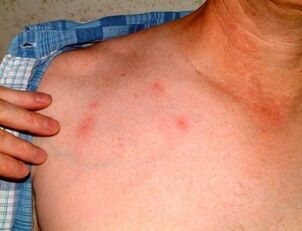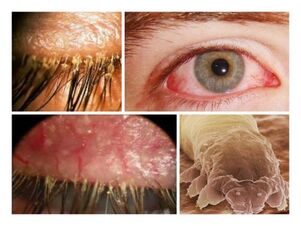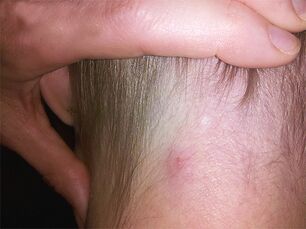
Photos and videos of the symptoms of skin parasites under humans are not a pleasant sight. Unlike intestinal worms, the existence of which one may not even know, epithelial infections are easily discernible. In this case, a person feels constant discomfort due to the symptoms that accompany the lesion. This will help you start diagnosing the disease and starting treatment as soon as possible. In humans, a photo of subcutaneous parasites evokes emotions close to disgust, but the symptoms of the infection are much more unpleasant. The image does not convey a person’s feelings from the recognition that someone is crawling on their body. But epithelial infections are not only an inconvenience, but a significant threat to the health of the entire body. The toxins excreted by the parasite’s body can affect all organ systems, and the helminths themselves are happy to spread throughout the human body. Thus, the manifestation of dermatological problems can be life-threatening due to the presence of helminth samples in the brain, visual organs, or heart.
What parasites live in the skin?
Dermatological problems can cause a wide variety of infections. If the presence of worms is most often diagnosed during an intestinal infection, insects and protozoa can also be found under the skin. Mosquitoes, ticks, and other blood-sucking parasites usually feed unnoticed and detach from humans, but there are some that live and multiply in the body.
Each infection has its own way of entering the human body. The symptoms and effects of the infection are also very different. Accordingly, the disease is treated in different ways. But in order to distinguish one parasitic infection from another and determine who lives in the body, a long diagnosis must be made. The physician, knowing the characteristics and habitats of the various parasites, will suggest the most likely option even before the tests begin, focusing only on the symptoms and the patient’s worldwide travel map.
Parasitic microorganisms
The most common such disease is leishmaniasis. It is caused by the simplest parasites that have named the pathology. Of the 10 infections, 9 occur in only a few countries:

- Syria;
- Iran;
- Saudi Arabia;
- Afghanistan;
- Peru;
- Brazil.
The disease is transmitted by mosquitoes and some fly species. Pathogenic microorganisms do not survive in temperate climates, so after resting in hot countries with tropical climates, they can only become infected with leishmaniasis.
When infected, the infection forms an ulcer at the site of the insect bite. Over time, the scar heals and remains disordered. With multiple foci, leishmaniasis may appear as leprosy. The danger of this disease is that it passes from the skin into the lymphatic system and can affect the internal organs, gradually destroying them. At the same time, parasites live inside cells, so immune bodies have little use in the fight against protozoa. But after a single experience of fighting leishmaniasis, immunity develops.
Insects among subcutaneous parasites
Diseases caused by such invasions are called entomoses. There are several versions of these subcutaneous parasites in humans:
- Sarcopsylosis (tungiasis).Tropical sand flea calls it. It is enough to walk barefoot on the beach or go to bed basking in the sun for the insect to climb on the body. It hides unnoticed under the outer layer of the epithelium until the blood is drunk. The flea then “becomes obese” and puts pressure on the surrounding tissues, causing discomfort. When he dies, he is excreted from the body with dead peeling skin. If this does not happen, the tissue can become infected and create an abscess.
- Dermatobiasis.South American human fungus injects larvae under human skin. When fully developed, tissue is torn and left in the body, leaving an open wound. Damage to the skin above the eyelids and cartilage can have health consequences.
- Acariasis.These diseases are caused by ticks. The most famous is the scabies, which lives and multiplies under the skin, feeding on its cells. Symptoms of scabies can be easily distinguished from itchy hives by filamentous streaks — the epidermis chewed by the female parasite. Another mite, Demodex, causes dermatitis and baldness.

Most often, insects that settle in the human body live in southern countries because they need a stable warm climate to develop. In some cases, however, it is enough to visit the sea in the summer and then be able to fight the subcutaneous parasites for several months.
Parasitic pearworms and more
Subcutaneous worms are not difficult to detect in humans. They are usually sold in the same way as other infections - through redness, itching and burns. But in some cases, the epithelium is only an intermediate stop, and the main development of the pathology in the internal organs continues:
- Dirofilariasis.There are several types of these helminths. Some prefer to settle in the internal organs, but there are those that affect the skin and eyes. Parasitic larvae are carried by mosquitoes and are found in warm areas. A painful, soft, movable lump swells at the site of the lesion. It is not dangerous if the infection does not affect the visual organs. But treatment requires surgery.
- Dracunculiasis.The rishta worm enters the body with water that contains small crabs that store larvae in the stomach. Through the intestines, helminths penetrate the abdominal cavity, where they mate and lay eggs in the muscle tissue in the joints and leg bones. When the new worm matures, the larva breaks through the skin and emerges. The only way to relieve the burning sensation and pain is to immerse the limb in water. Other methods of releasing a parasite that has settled in the body have not yet been invented.
- Schistosomiasis.Not all worms get food under human skin. To infect with schistosomes, it is sufficient to swim in the freshwater of tropical countries in South America, the Caribbean, Africa, or Southeast Asia. The skin lesion is reminiscent of scabies and is accompanied by tingling. But after a while, the larvae get deep into the body, after which the epithelial symptoms disappear and the next stage of the disease develops.
- Gnathostomosis.Humans are not natural hosts for this parasite. Therefore, worms are unable to multiply in the body. Therefore, the Asian parasite is ingested by fish, frogs, or inadequately heat-treated birds. The larvae begin to migrate after a month. Moving under the skin causes itching, redness and pain. The abdominal appearance is accompanied by edema.

Once the first signs of helminth life appear under the skin, the patient should be examined and treatment initiated. Many parasites can significantly worsen health, including disability, if not removed in a timely manner.
Diagnostic Procedures
Given the diversity of parasites living under human skin, there is no one-size-fits-all method to help determine the cause of the disease. Nor should we forget that insects and worms are not the only source of possible dermatological problems. Allergic reactions, fungal growth, and bacterial infections are much more likely to cause hives and dermatitis.
The first phase of the search for parasites on human skin begins with an investigation. The doctor will perform an assessment, examine the affected areas, and ask for other symptoms. So you will be able to narrow down your search area and in some cases, such as dracunculiasis and dirofilariasis, you may immediately prescribe treatment.
If the physical examination did not help to clarify the image completely, laboratory and hardware diagnostic methods are assigned:
- Blood test.General analysis reveals the body's reactions to infection. Thus, one skilled in the art can determine the nature of the disease. When performing biochemistry, it is worth paying attention to the indicators of erythrocyte sedimentation rate and eosinophil content. If elevated, helminthiasis is quite likely. ELISA analysis is the most accurate. The presence of antibodies helps to determine even the exact type of parasite, if any, in the body.
- Stool analysis.Many subcutaneous worms are initially located in the intestines. By examining the feces, you can find the helminth eggs and start the treatment.
- Biopsy.Analysis of the contents of the affected tissues, purulent abscesses and blisters, swollen lymph nodes can also give an idea of the disease.
- Ultrasound, X-ray, CT and MRI.Various hardware methods of "scanning" the body help locate the source of the infection under the skin and in the internal organs. In some cases, this is the only effective diagnostic method.

Some infections can only be diagnosed after treatment, when the parasite is removed from the skin.
Treatment of parasitic diseases
Depending on the type of parasite, doctors need to use different methods to get rid of the infection:
- The simplest microorganisms are killed by a course of antibiotics. It must be accompanied by symptomatic treatment.
- You can get rid of ticks with the help of special ointments and tablets. However, dermatobiasis can only be cured with surgery by removing the larvae from under the skin.
- The way to treat helminthiasis depends directly on the type of parasite. Thus, dirofilariasis is only treated surgically. Antihelmetics help get rid of schistosomes and intestinal parasites. And treatment for dracunculiasis is not provided at all. A person has to wait for the worm to leave the body on its own and deal with the symptoms: pain and inflammation.
In any case, in order to completely eliminate the parasites, he must undergo a full medical examination and start treatment under his guidance.






































